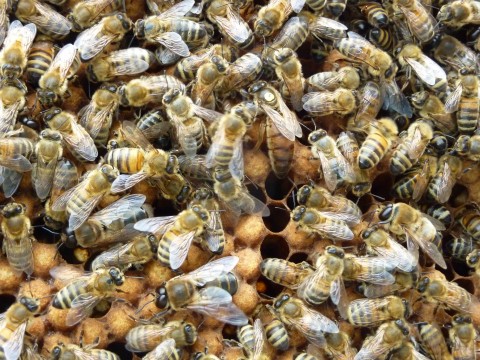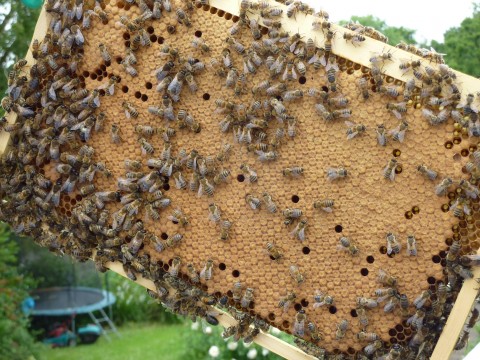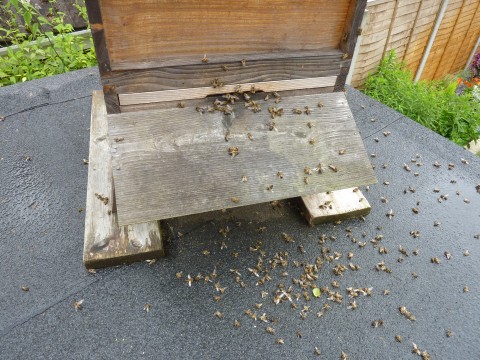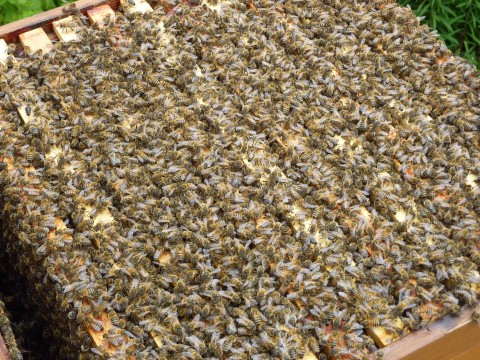 Abraham Lincoln
If given the truth, the people can be depended upon to meet any national crisis...
Abraham Lincoln
If given the truth, the people can be depended upon to meet any national crisis...
 Guildford news...
for Guildford people, brought to you by Guildford reporters - Guildford's own news service
Guildford news...
for Guildford people, brought to you by Guildford reporters - Guildford's own news service
Beekeeper’s Notes July 2015
Published on: 3 Jul, 2015
Updated on: 3 Jul, 2015
Bees Dying By The Hundred!
In the latest in a series of Hugh Coakley’s Beekeeper’s Notes, he writes about one of the disease problems that bee colonies face.
American scientists recently reported that planet Earth’s third mass extinction phase is on us now. That is serious stuff.
When a beekeeping friend called to say that there were hundreds of dead bees in front of his hive, it did make me think. It must be really bad if even leafy Surrey is involved.
He said that some were even dying as they landed on the hive.
It raised lots of questions. Could it be that the bees were foraging in an area that had been sprayed by insecticide?
Was it down to disease? There were no obvious signs on the outside. No unpleasant smell, no tell-tale specks and smears of bee poo – only dead and dying bees.
Possibly, starvation in the June gap? There can be a shortage of pollen and nectar-rich plants in the gap between spring and summer. This can hit a colony badly if they have nothing to survive on.
Others we asked suggested that possibly the poor old bees were just clapped out after working their socks off during the spring.
When we looked in the hive, we were expecting to see carnage but that was not the case. There were plenty of bees as you can see from the photo above.No sign of dead bees inside, no starvation or obvious disease. The queen was laying eggs like a factory load of battery chickens. The frames in the hive were covered in ‘wall to wall’ developing brood.

The prolific queen moving about the hive. She has a yellow spot painted on her thorax to make her easier to spot.
The photo below shows that queen had laid in virtually every available location and had completely covered the frame. It looked like a strong, healthy hive.

A healthy looking frame. A bee larvae is developing inside each hexagonal cell. The queen can lay 1,500 to 2,000 eggs a day.
So what was happening?
My colleague called in the local government bee inspector who straight away recognised the problem. He said that he had seen a number of hives in the region similarly suffering and he thought that it was a bee virus. In particular, he named it as chronic bee paralysis virus which is quite rare, but the inspector felt that it was getting more frequent.
Luckily, there was no treatment required as the hive is strong and, cross fingers, they will get over it.
So no mass extinction in Guildford yet – but it does make you think.
Recent Articles
- Guildford Institute’s Crowdfunding Project for Accessible Toilet in its New Community and Wellbeing Centre
- Letter: Guildford – Another Opportunity Missed?
- Letter: GBC’s Corporate Strategy – Where Is the Ambition?
- My Memories of John Mayall at a Ground-breaking Gig in Guildford Nearly Six Decades Ago
- Westborough HMO Plans ‘Losing the Heart of the Street’ Says Resident
- College Invests to Boost Surrey’s Economy and Close Digital Skills Gap
- Community Lottery Brings Big Wins for Local Charities
- GBC Housing Plan Promises ‘A Vibrant Urban Neighbourhood’ Near Town Centre
- Hospital Pillows ‘Shortage’ at the Royal Surrey
- Updated: Caravans Set Up Camp at Ash Manor School


Search in Site
Media Gallery
Dragon Interview: Local Artist Leaves Her Mark At One of England’s Most Historic Buildings
January 21, 2023 / No Comment / Read MoreDragon Interview: Lib Dem Planning Chair: ‘Current Policy Doesn’t Work for Local People’
January 19, 2023 / No Comment / Read MoreA3 Tunnel in Guildford ‘Necessary’ for New Homes, Says Guildford’s MP
January 10, 2023 / No Comment / Read More‘Madness’ for London Road Scheme to Go Ahead Against ‘Huge Opposition’, Says SCC Leader
January 6, 2023 / No Comment / Read MoreCouncillor’s Son Starts Campaign for More Consultation on North Street Plan
December 30, 2022 / No Comment / Read MoreCounty Council Climbs Down Over London Road Works – Further ‘Engagement’ Period Announced
December 14, 2022 / No Comment / Read MoreDragon Interview: GBC Reaction to the Government’s Expected Decision to Relax Housing Targets
December 7, 2022 / No Comment / Read MoreHow Can Our Town Centre Businesses Recover? Watch the Shop Front Debate
May 18, 2020 / No Comment / Read More











Recent Comments